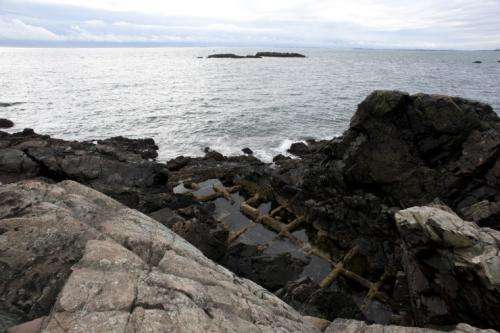Climate models suggest major changes in coastal marine ecosystems

Climate change over the 21st century will significantly alter an important oceanographic process that regulates the productivity of fisheries and marine ecosystems, according to an interdisciplinary research team led by Northeastern University.
The researchers' analysis of an ensemble of models indicates that by the end of the century, coastal upwelling—a process by which deep, cold and nutrient-rich water rises to the surface—will begin earlier, end later, and increase in intensity at higher latitudes. This will result in a significant decrease in the existing latitudinal variation in coastal upwelling, which is likely to influence the geographical distribution of marine biodiversity on a global scale.
The team's findings are reported in a paper to be published in the Feb. 19 issue of the journal Nature. The paper is published online Wednesday.
"It's critically important to understand how coastal upwelling might change in a warming climate," said co-author Auroop Ganguly, a climate change expert at Northeastern. He noted that this study is the first to identify a consistent pattern of intensification and spatial homogenization of coastal upwelling under greenhouse warming in the latest generation of climate models.
The Northeastern research team comprised Ganguly, an associate professor in the Department of Civil and Environmental Engineering; Tarik Gouhier, an assistant professor in the Department of Marine and Environmental Sciences at Northeastern's Marine Science Center; and Daiwei Wang, a postdoctoral researcher in Ganguly's lab. Bruce A. Menge, a professor in the Department of Integrative Biology at Oregon State University, also collaborated on this research and co-authored the paper.
"We focused on these upwelling changes that are robust and consistent across models and geographical regions because they are most likely a consequence of global climate change," said Wang, the study's lead author.
This work dovetails with Northeastern's commitment to interdisciplinary research that addresses global challenges in sustainability by bringing together two research labs whose pursuits are intertwined. Ganguly directs Northeastern's Sustainability and Data Sciences Laboratory, which studies weather extremes, water sustainability, and marine or urban ecology under climate change as well as the resilience of critical infrastructures and lifelines under natural or man-made hazards. Gouhier's lab focuses on developing dynamical models to understand how ecological and environmental processes occurring at different scales and levels of organization interact to shape the spatiotemporal distribution of marine biodiversity in an era of global change.
"This crossover research in climate and marine processes clearly demonstrates the power of the interdisciplinary research occurring here at Northeastern," said Nadine Aubry, dean of the College of Engineering. "Drs. Ganguly, Wang, and Gouhier are providing key insights into the challenges and adaptation of our planet's ecosystems, and I look forward to Northeastern's continued impact in this critically important area."
"The collaboration between Auroop, Tarik, and their colleagues epitomizes the interdisciplinary approach needed to address the major issues facing our environment," added Geoff Trussell, director of the Marine Science Center and professor and chair of the Department of Marine and Environmental Sciences. "The Urban Coastal Sustainability Initiative at Northeastern University embraces and promotes this type of collaboration and is what brought this team together. By bringing both unique and overlapping perspectives to these issues, these scientists have produced key insights."
Wang, whose background is in climate dynamics and physical oceanography, found his scientific and computational expertise put to good use in this interdisciplinary study. "The leadership and ability to bridge climate and marine sciences demonstrated by Daiwei in this research have been exemplary, showing what can be accomplished through interdisciplinary training," added Ganguly.
The researchers examined four upwelling current systems found in the Atlantic and Pacific oceans. While these four systems cover less than 2 percent of the ocean's surface, they contribute more than 20 percent of the global fish catches. Citing their analysis of climate models, the researchers projected the upwelling season would expand by several days per decade between 1950 and 2099 at high latitudes in all four systems.
What's more, they found noticeable differences between the Northern and Southern hemispheres. The two Southern Hemisphere systems showed larger and more consistent trends than the two Northern Hemisphere systems. Still, "despite regional differences, the lengthening of the upwelling season at high latitudes in [the four systems] is a robust global response to greenhouse warming," they wrote.
Upwelling, Gouhier explained, is an important process that drives the availability of nutrients in the marine food web. Upwelling promotes nutrient availability, which makes phytoplankton more abundant. Zooplankton then feed off phytoplankton, and fish feed off zooplankton. Increased upwelling in higher latitudes would promote more productive fisheries and marine ecosystems. However, the researchers warned that having too many nutrients cycling through a marine ecosystem could lead to hypoxic conditions, or "dead zones," over large swaths of the coastal ocean. These are regions where the overabundance of nutrients thrust bacteria into hyper-drive and the resulting metabolic activity causes a reduction of the concentration of oxygen in the water, which can lead to mass die-offs.
"Simply put, too much of a good thing can be really bad," Gouhier said.
Coastal upwelling happens year-round at locations closer to the equator, but its duration and intensity is reduced at higher latitudes. However, if coastal upwelling becomes stronger and more persistent at higher latitudes, as the models suggest, then there will be a reduction in the existing latitudinal variation in coastal upwelling, which may generate a concomitant reduction in of marine biodiversity. In other words, the composition of marine communities at high and low latitudes will become more similar.
This could put species in greater competition with each other and create more species turnover in the coastal ocean, the researchers said. As a result, hotspots where upwelling changes are occurring should be closely monitored to ensure the stability and productivity of fisheries and coastal ecosystems.
More information: "Intensification and spatial homogenization of coastal upwelling under climate change." Nature 518, 390–394 (19 February 2015) DOI: 10.1038/nature14235
Journal information: Nature
Provided by Northeastern University





















